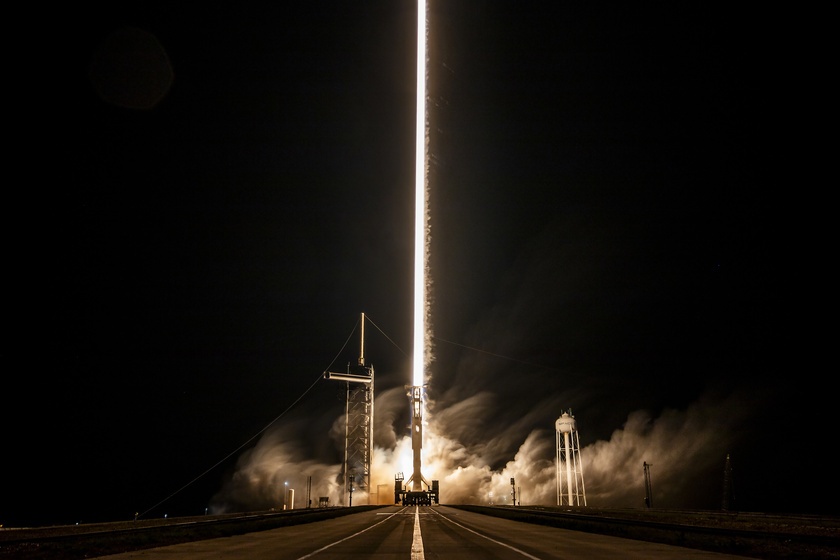A SpaceX Falcon 9 rocket launched the USSF-36 mission carrying U.S. Space Force's X-37B Orbital Test Vehicle(OTV-8, on its own eighth mission), from Pad 39A, in NASA's Kennedy Space Center(KSC), Florida at 0350 UTC on Aug, 22.
The Falcon 9's first stage(B1092) returned to Earth as planned 8.5 minutes after liftoff producing a sonic boom heard across Brevard County, and touching down at Cape Canaveral Space Force Station, next door to KSC. The rocket's upper stage, meanwhile, continued spaceward deploying the X-37B in low Earth orbit(LEO).
The Space Force is believed to have two of the uncrewed 8.8-meter vehicles, both of which were built by Boeing. X-37B looks like a miniature version of NASA's now-retired space shuttle orbiters.
The USSF-36 mission is a classified flight, and the X-37B will spend an undisclosed amount of time in orbit conducting technology demonstrations for the U.S. Space Force. X-37B serves primarily as a testbed for sensors and other technology that the military wants to check out in Earth orbit, hence the space plane's other name -- the Orbital Test Vehicle (OTV).
On OTV-8 mission, the payloads are "next-generation technologies including laser communications and the highest-performing quantum inertial sensor ever tested in space," Space Force officials wrote in a July 28 statement.
A quantum inertial sensor is an instrument that allows spacecraft to gauge their acceleration, rotation and velocity using the principles of quantum mechanics.
"This technology is useful for navigation in GPS-denied environments and consequently will enhance the navigational resilience of U.S. spacecraft in the face of current and emerging threats," the July 28 statement reads. "As quantum inertial sensors would be useful for navigation in cislunar [Earth-moon] space, they additionally promise to push the technological frontiers of long-distance space travel and exploration."
The U.S. military also views laser-based communications as important to national security and American space superiority going forward. Laser comms are more secure than traditional radio-frequency systems because of their more targeted nature, and they can transmit more information.
During OTV-8, equipment aboard the X-37B will conduct laser-comms tests "involving proliferated commercial satellite networks in low Earth orbit," according to the July 28 statement.
"OTV-8's laser communications demonstration will mark an important step in the U.S. Space Force's ability to leverage proliferated space networks as part of a diversified and redundant space architecture," Chief of Space Operations Gen. Chance Saltzman said in the statement. "In so doing, it will strengthen the resilience, reliability, adaptability and data transport speeds of our satellite communications architecture."
One of those "proliferated space networks" is likely Starlink, SpaceX's huge and ever-growing broadband megaconstellation, which currently features more than 8,000 operational satellites in LEO. Several competitors are in the early construction phase, including Amazon's Project Kuiper, which to date has lofted 102 of its planned 3,200 satellites.
The X-37B — which launches vertically atop a rocket but comes down to Earth horizontally, on a runway — flew its first orbital mission in 2010. The vehicle's most recent previous flight, OTV-7, launched in December 2023 and landed on March 7 of this year.
That 434-day mission ended a pattern of ever-escalating duration. Previously, each X-37B sojourn had spent more time in space than its predecessors, from the 224-day OTV-1 to the 908-day OTV-6. We don't know how long OTV-8 is expected to last; that's one of the mission details that the Space Force keeps close to the vest.
OTV-8 is the third X-37B mission to launch on a SpaceX rocket. (Two have employed Falcon 9s and one lifted off on a Falcon Heavy). The other five flew atop United Launch Alliance's workhorse Atlas V, which is now being phased out in favor of the company's new Vulcan Centaur.
USSF-36 marked the fourth National Security Space Launch (NSSL) Phase 2 mission of the year and the third X-37B mission flown by SpaceX. The launch was conducted in cooperation with the Air Force Rapid Capabilities Office. USSF-36 is part of a record number of NSSL missions scheduled for the next 12 months.
The Falcon 9 booster, B1092, used in this USSF-36 mission was making its sixth flight, having previously launched missions including NROL-69, CRS-32, GPS III-7, and two Starlink missions.















